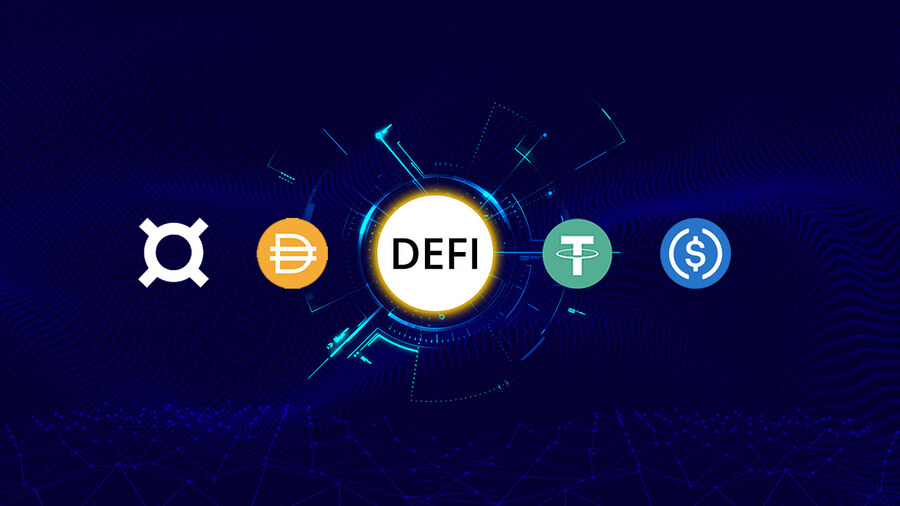DeFi Stablecoins: An Introduction
DeFi stablecoins are digital assets that are designed to maintain a stable value, usually pegged to the value of a fiat currency such as the US dollar. These stablecoins are a key component of the DeFi ecosystem, providing users with a way to access the benefits of blockchain technology without being exposed to the volatility of other cryptocurrencies such as Bitcoin or Ethereum.
In this article, we will take a closer look at DeFi stablecoins, how they work, and their importance in the DeFi ecosystem.
Types of DeFi Stablecoins
There are several different types of stablecoins in the DeFi space, each with their own unique features and characteristics.
- Fiat-Collateralized Stablecoins: These stablecoins are backed by a reserve of fiat currency, such as the US dollar, held in a bank account. Examples of fiat-collateralized stablecoins include USDT, USDC, and TUSD.
- Crypto-Collateralized Stablecoins: These stablecoins are backed by a reserve of other cryptocurrencies, such as Bitcoin or Ethereum. Examples of crypto-collateralized stablecoins include DAI, sUSD, and BUSD.
- Algorithmic Stablecoins: These stablecoins are not backed by any physical asset, but rather rely on a complex algorithm to maintain a stable value. Examples of algorithmic stablecoins include Ampleforth, Basis Cash, and Frax.
How DeFi Stablecoins Work
DeFi stablecoins work by maintaining a peg to a fiat currency, such as the US dollar. This is typically achieved through a combination of collateralization, arbitrage, and market incentives.
Fiat-collateralized stablecoins are backed by a reserve of fiat currency held in a bank account. When users buy or sell these stablecoins, the reserve is adjusted to maintain the pegged value. For example, if the price of USDC drops below $1, new stablecoins are minted and sold to increase the reserve, bringing the price back up to $1.
Crypto-collateralized stablecoins work in a similar way, but are backed by a reserve of other cryptocurrencies, such as Bitcoin or Ethereum. When the price of the stablecoin drops below its peg, new stablecoins are minted and sold for the reserve cryptocurrency, increasing the reserve and bringing the price back up to the pegged value.
Algorithmic stablecoins use a different approach, relying on a complex algorithm to maintain the stable value. When the price of the stablecoin deviates from the peg, the algorithm adjusts the supply of the stablecoin to bring the price back to the pegged value.
Benefits of DeFi Stablecoins
There are several benefits to using DeFi stablecoins, including:
- Stability: Stablecoins are designed to maintain a stable value, making them less volatile than other cryptocurrencies.
- Accessibility: Stablecoins enable users to access the benefits of blockchain technology without being exposed to the volatility of other cryptocurrencies.
- Speed: Transactions with stablecoins are typically faster and cheaper than traditional fiat transactions.
- Privacy: Stablecoins offer users greater privacy than traditional financial systems, as transactions can be conducted pseudonymously.
- Decentralization: Many DeFi stablecoins are decentralized, meaning that they are not controlled by any single entity, making them more transparent and resistant to censorship.
Risks and Challenges
Despite their many benefits, there are also risks and challenges associated with DeFi stablecoins.
One of the main risks is the issue of collateralization. If the reserve backing a stablecoin is not sufficient to cover the value of the stablecoin in circulation, it could lead to a catastrophic loss of value.
Another risk is the issue of centralization. While many DeFi stablecoins are decentralized, there are also centralized stablecoins that are issued by centralized entities, which can pose a risk to the decentralized nature of the DeFi ecosystem.
Another challenge is the issue of regulatory compliance. Stablecoins, particularly fiat-collateralized stablecoins, are often subject to regulatory scrutiny and may face legal challenges in some jurisdictions.
Finally, there is also the risk of market manipulation. Stablecoins are vulnerable to market manipulation, particularly in cases where the market is illiquid or controlled by a small number of actors.
Future Outlook
Despite the challenges and risks, the future of DeFi stablecoins looks bright. As more users seek to access the benefits of blockchain technology, stablecoins are likely to become an increasingly important component of the DeFi ecosystem.
Moreover, the rise of algorithmic stablecoins, such as Ampleforth and Frax, may provide new avenues for stablecoin innovation, particularly in cases where traditional collateralization methods are not feasible or desirable.
One potential area for future growth in the DeFi stablecoin space is the development of stablecoins that are not tied to fiat currencies, but rather to other assets or indices. For example, there has been interest in the development of stablecoins that are tied to the value of commodities such as gold or oil, or to stock market indices like the S&P 500.
This approach has the potential to address some of the concerns associated with fiat-collateralized stablecoins. By tying stablecoin value to a diversified set of assets, stablecoin issuers can potentially reduce the risk of a single point of failure in the event of a market downturn or financial crisis.
Another potential area for innovation is in the development of hybrid stablecoins that combine both collateralized and algorithmic approaches. These stablecoins could leverage the benefits of both approaches, providing users with greater stability and scalability.
Finally, the development of interoperability solutions could further enhance the utility of DeFi stablecoins. By enabling different stablecoins to interact with each other and with other DeFi protocols, users could access a wider range of financial products and services, while also benefiting from increased liquidity and reduced transaction costs.
Overall, the potential for innovation and growth in the DeFi stablecoin space is significant. As the DeFi ecosystem continues to evolve, stablecoins are likely to play an increasingly important role in enabling users to access the benefits of blockchain technology in a stable and secure manner. While there are risks and challenges associated with stablecoins, the potential benefits for users and the broader financial system are significant.
Conclusion
In conclusion, DeFi stablecoins are an important component of the DeFi ecosystem, providing users with a way to access the benefits of blockchain technology without being exposed to the volatility of other cryptocurrencies. While there are risks and challenges associated with stablecoins, their future looks bright as they continue to play an increasingly important role in the DeFi ecosystem.
I am a highly experienced and successful cryptocurrency author. I have been writing about cryptocurrencies for over 5 years and have seen the industry grow and change immensely. I am well-versed in all things crypto and blockchain, and it can be seen in my writings. My goal is to educate others about this fascinating industry, and to help them make informed investment decisions. I believe that cryptocurrencies are the future of finance, and I am eager to share my knowledge with as many people as possible.




